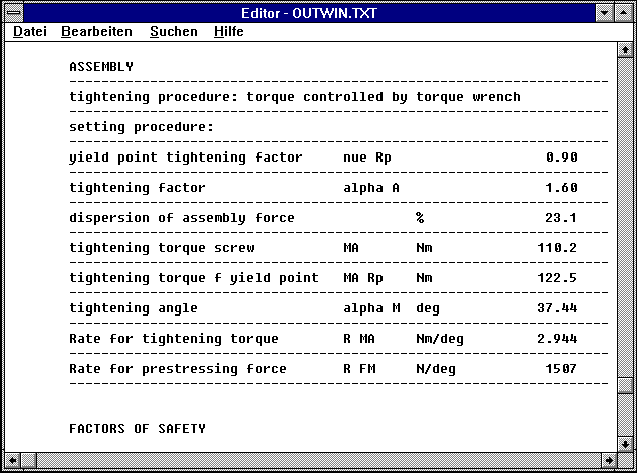HEXAGON Info No. 40 Nov/Dec 1996
SR1 - Tightening Process
New in our bolt program are an M-alpha diagram showing tightening torque over the rotation angle and an FM-alpha diagram with the clamping force over the rotation angle. The theoretical lines without head and thread friction are also included along with the amont of thread friction. I would like to thank Mr Shoberg of RS Technologies in Farmington Hills/USA for his suggestions.
 The curves demonstrate how dangerous purely torque controlled bolted joint tightening is. It only takes a lubricated bolt with lowered thread friction and the head breaks off. Rotation angle controlled tightening is much more precise. The necessary rotation angle, from the where clamping commences until the required pre-stress force is achieved, is calculated by SR1 and is only
marginally dependent upon friction. The difficulty lies in defining the zero point from which should be measured. In theory, this is the point at which the torque becomes measureable on a torque tool. In practice however, a small thread defect and dirt can already be all that is necessary for a constant or irregular alternating moment to screw in the bolt. For this reason RS
Technologies records the torque/rotation angle curve and calculates the "elastic starting point" by touching the curve with a tangent. The bolt is tightened from the elastic starting point up to the torque calculated by SR1.
The curves demonstrate how dangerous purely torque controlled bolted joint tightening is. It only takes a lubricated bolt with lowered thread friction and the head breaks off. Rotation angle controlled tightening is much more precise. The necessary rotation angle, from the where clamping commences until the required pre-stress force is achieved, is calculated by SR1 and is only
marginally dependent upon friction. The difficulty lies in defining the zero point from which should be measured. In theory, this is the point at which the torque becomes measureable on a torque tool. In practice however, a small thread defect and dirt can already be all that is necessary for a constant or irregular alternating moment to screw in the bolt. For this reason RS
Technologies records the torque/rotation angle curve and calculates the "elastic starting point" by touching the curve with a tangent. The bolt is tightened from the elastic starting point up to the torque calculated by SR1.
SR1 - Printout
The SR1 printout includes the tightening rotation angle along with bolt expansion and plate compression, as well as the spring contstants.

SR1 Safety Against Breakage
SR1 provides the safety margins agains over-expansion during tightening and against fracture. The output for the safety against breakage (static) is new
S = (Rp0.2 * A0)/(Fvmax+FSA)
with the yield point Rp 0.2, the stress cross-section or smallest bolt cross-section A0, the bolt pre-stress force from the maximum tightening torque and the bolt additional force FSA from the Load FAo. I would like to thank Mr Willems of Tacke Windtechnik for this idea.
SR1 - Surface Pressure
The surface pressure on the clamping pieces has, until now, been calculated with: pmax = (FM + phi n * FA) / Amin. This did not take into account that FA, dependent upon the force application point, is not only an additional load, but can also lead to load relief effect on the clamping surfaces. In the new version, the additional surface pressure due to FA is now only accounted
for on the clamping surfaces on which additional load occurs. Load relief due to FA is not accounted for, as high pressure occurs, at least, during the assembly process. I would like to thank Mr Moser of TU, Graz, Austria for drawing my attention to this.
ZAR3 - Angle in Degrees, Minutes, Seconds
Since the angle on the machine is set in degrees, minutes and seconds, the output has been adjusted to reflect this. Thank you to Karl-Heinz Liedtke in Enschede, our HEXAGON Software representative in Holland, for pointing this out.
Several DXFPLOT Command Lines
Usually different settings are required for the output of drawings and diagrams. For example, during output of the production drawing in FED1 at a scale of 0.9 on a DIN A4 page the diagrams are adjusted with the option "/M*" and turned by 90ø with "/R". In order not to have to change the DXFPLOT line each time, you can now pre-define up to five DXFPLOT command lines under
"Settings->DXFPLOT". I would like to thank Mr Brecht of KSB Pumpen, Frankenthal, Germany for this improvement suggestion.
FED - Program Crash
A program crash may occur during the life expectancy calculation when a life expectancy of less than one load change is calculated for a compression or extension spring. In this case the life expectancy will no longer be calculated and an error message will be displayed. I would like to thank Mr Freitag of Voss Springs for drawing may attention to this.
Fritz Ruoss
HEXAGON Industriesoftware GmbH
Stiegelstrasse 8
D-73230 Kirchheim/Teck (Germany)
Tel.: +49-7021-59578
Fax: +49-7021-59986
Mailbox BBS: +49-7021-480015 (Modem 28800..2400bps)
Mailbox BBS: +49-7021-959242 (ISDN 64000bps)
Return


